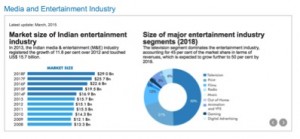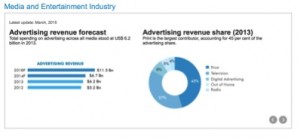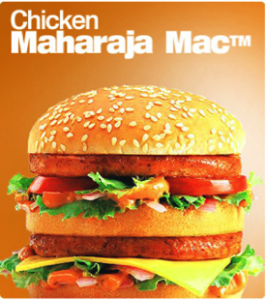Advertisement in India
Barbora Černáková & Daniel Szabó
India is the second most populous country having over 1 billion inhabitants. Linguistically, it is the most complex country in the world. There are 18 official languages written in 10 different scripts. However, the advertisement had to go a long way to fully utilize the potential of the country. After the independence from Great Britain in 1947, M. Ghandi called for a boycott of imported goods and this approach of suspicion about foreign goods remained in Indians for following decades. The turning point came in year 1991 when the government liberalized the market and nowadays it is possible to buy almost anything in the country, unfortunately not for everyone. From the whole population there are about 300 million people who represent the middle class that we know from Europe or the United States. For the rest, even the tea or soap are goods of luxury.
Anthropologist W. Mazzarella (2003) divides advertisement of independent India in 4 phases. The first phase lasted from the announcement of independence in 1947 until early 1960s. The advertisement lacked creativity and was working more or less like a British outpost. This period was also unique because of 2 ingredients Indian advertisement had – advertising was perceived as tainted and it was almost only in English language. In the second phase (until 1980s), which was a reaction to the first one, creativity and Indian individuality independent from Great Britain were emphasized. This stage experienced also another 2 developments. The first one was the emergence of new Indian middle class that was associated with the “green revolution” taking place in North India which brought prosperity to a large amount of people there. The second important event was the National Readership Survey (NRS) I and II in years 1970 and 1978. These two surveys discovered the potential of rural market that it is worth publishing and advertising not only in English language but also in the rural ones. This meant a landmark for Indian capitalism. The third and fourth phase (from late 1980s until now) focused on effective marketing channels and high level of creativity. The Indian advertising industry grew by almost 25 times between 1976 and 1994. What is interesting is that multinational companies, advertisement and globalization actually helped to vitalize and reinforce local languages and cultures because the advertisement had to be written or produced also in these languages in order to be successful.
Nowadays the largest contributors to advertising are television and print. The third largest contributor is the Internet. By the 2018 the print should be replaced on the first place by television. The media and entertainment industry in India is expected to 9,6 billion dollars by 2018, while in 2013 it was only 5,6 billion.
Kishore Dash, a professor of marketing and a specialist on the Indian economy, describes the consumption patterns in contemporary India:
“Since the mid-1980s, Indian society has undergone a dramatic shift in social values. …Getting rich and enjoying a good life has become the new mantra of social existence for the Indian middle class. With more income and more purchasing power, the status-conscious Indian middle class now seek to buy good quality consumer products and spend more money on food and entertainment…While 70% of Indians are still traditional, poor, and live in rural areas, 30% of Indians (more than 300 million people) have emerged as rich, modern, Western-exposed, English-speaking, urban dwellers.”
Use of media in India seems as a perfect spot for understanding the connection between global and local. Media actors and media themself construct this connection in a very meaningful way, because they are actually trying to render the global products accessible to local audience and this way create a special desire for obtaining them. As we saw, advertisement in India has been experienced a long development since it got up to this point. The need of cultural translation and the task of the ethnographers to describe the foreign culture are here obviously more than necessary.
Between the most significant authors dealing with the advertising strategies in India belong William Mazzarella (2003) and Niaz Ahmed (1996). Both of them are focused on the global-local intersection within the creation of the locally accessible advertisement. Between the main questions they pose belong: How advertising reflects cultural values of its target audience? Are consumers becoming homogenous? What are the differences and similarities in advertising strategies and expressions?
Niaz Ahmed uses the expression “effective localized advertising”, when the ads strategies actually reflect cultural values and norms of its intended audience. At the same time Mazzarella considers the advertisement business as an ideal site, where “country-specific symbols” (culturally specific knowledge) encounter the “global” and where we can observe the mediation between the role of consumerism and advertising in the development of a local Indian identity (Mazzaerella, 2003).
For understanding, how this actually work, we will provide 2 examples of successful campaigns, which were able within the global context make certain local contents, icons and images accessible in order to approach local society. These recognized the specific and authentic characteristics of Indian culture and employed them in a various ways.
India represented a big challenge for McDonald, because it is a country where cows are sacred and McDonald had to adjust to a totally different cultural context. There are Hindus who do not eat meat, Muslims who do not eat pork and a significant part of population doesn’t eat any animal products at all. No surprise that the company spent four years until finally in 1996 McDonald entered the Indian market.
Despite carefully planned strategy, there were major problems at the beginnings. Even tough they stepped from incorporating beef in their products; the Maharaja Mac with mutton was unappealing to the Indians. Besides that, there was a perception among the people that McDonalds restaurants are too expensive. To change this perception the company created a commercial with a look-alike for Bollywood star Dev Anand from 1980s that speaks that prices are from his generation. In this video he appears to be black and white while the surroundings of McDonalds restaurant are shiny and colourful.
ACHTUNG: Daten nach YouTube werden erst beim Abspielen des Videos übertragen.
The most important adaptation that brought successful results was dividing the restaurant into vegetarian and non-vegetarian part. This division were kept separate and also their kitchen was separated. Even the employees that worked in vegetarian part had to wear green that indicated that they cook, sell and touch vegetarian food and the same went for the employees that worked in non-vegetarian part who wore red. This had been a very important step in convincing the Indians that McDonald doesn’t contaminate its non-meat foods in any way. The most successful items in Indian version of McDonald are McChicken Sandwich, the McAloo Tikki and Chicken Maharaja Mac, that is an Indian version of Big Mac (two non-beef patties on a sesame seed bun).
In sum the success of McDonald in India lies in these points – they adapted their menu to the local context and food preference of the inhabitants, respected the food taboos and strong vegetarian tradition, placed Indians in top management positions, demonstrated interest for environmental issues and participated in local cultural, educational and sports events. They implemented the strategy – thinking globally, acting locally.
The second one is the campaign for condoms. Prior to this private’s company campaign, the result of the official state’s campaign, which was primarily created in order to control the population growth, condoms were associated with a sense of civic responsibility and population control. Indians considered this attempt as “a governance interference into private lives”, which obviously lessened the sexual pleasure.
ACHTUNG: Daten nach YouTube werden erst beim Abspielen des Videos übertragen.
The task, which the private company was confronted with, was to confront this generally negative image of condom and makes the product pleasurable. KamaSutra Condom was the name of the campaign and it literally repositioned the product as a means to pleasure and fulfillment in a presence of popular Bollywood stars.
ACHTUNG: Daten nach YouTube werden erst beim Abspielen des Videos übertragen.
The campaign this way represented a shift in consumerism away from social duty towards the personal choice. Besides, both campaigns revealed the increasing tendency of Indians towards the “global”, where in a connection with unique, traditional, local culture symbols create an alignment of new market liberalization in India.
Current mass consumption certainly represents a distinct break with more ancient Indian traditions. Despite this opposition, however, the advertisements strives to mix together the “old” with the “new”, instead of simply replacing global with traditional and puts an Indian face to the global products (Nike, McDonald, Coca Cola…). This way is product accessible to local consumers and at the same time desirable.
ACHTUNG: Daten nach YouTube werden erst beim Abspielen des Videos übertragen.
ACHTUNG: Daten nach YouTube werden erst beim Abspielen des Videos übertragen.
References:
Mazzarella, W. (2003): Shoveling Smoke: Advertising and Globalization in Contemporary India. Duke University Press
Niaz A. (1996). Cross-Cultural Analysis Of Contemporary Advertising From The United States And India. Ph.D, University of Southern Mississippi
Jeffrey, Robin (1997): Advertising and Indian-Language Newspapers: How Capitalism Supports (Certain) Cultures and (Some) States, 1947-96. In: Pacific Affairs, Vol. 70, No. 1 (Spring, 1997), pp. 57-84
O’Barr, William B. (2008): Advertising in India [online] Available from: https://muse.jhu.edu/journals/advertising_and_society_review/v009/9.3.o-barr.html#f11-text [Accessed: 17th May 2015]





 Die
Die